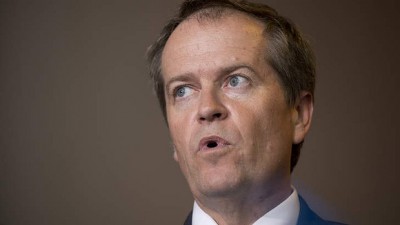All normal straight Australians should give thanks to the Lord Above that Stuffit Shorten DID NOT GET IN and wreck the joint.Labor to Throw $200bn to the Wind: Electricity Bill Shorten’s Economic Suicide Pact UnpackedMay 16, 2016 by stopthesethings 7 Comments

Electricity Bill Shorten: Certified Economy Killer
In the cutting British satire, Extras, the hapless Andy Millman (Ricky Gervais) is always foiled by his gormless but lovable side-kick, Maggie Jacobs (Ashley Jensen).
Maggie, when she’s not inadvertently ruining Andy’s romantic hopes and/or acting career prospects, poses puzzling rhetoricals such as “would you rather be trampled by elephants or eaten by lions?”
Following Maggie’s lead, STT poses the following:
“would you rather have your economic future destroyed by a $45 billion electricity tax, designed to subsidise the construction of another 6,000 of these things; or a $90 billion electricity tax, designed to subsidise the construction of another 12,000 of them?”
Unfortunately, unlike Maggie’s death by elephant or lion conundrum, with STT’s poser there isn’t any way of avoiding one or the other. Here, it’s the ‘choice’ that Australians face at the upcoming Federal election: or as Maggie might put it, “would you rather be run over by a steam-roller, once or twice?”
Terry McCrann and Alan Moran detail the ‘Maggie Jacob’s options’ faced by Australian voters, as follows.
Long and Bill Shorten of it: be afraidThe Australian Terry McCrann 7 May 2016
This is the budget which announces that Australia is now ungovernable. That the system — that messy mix of politics and policymaking — is simply incapable of making the necessary changes to put the country on even a sustainable, far less a dynamic, growth path.
That’s in a sense the ‘good,’ or perhaps rather the ‘least worst’, news; for the other major thought from the week is that it might be time to be afraid, to be really afraid.
Opposition leader Bill Shorten gave a very impressive budget reply speech on Thursday night, in my judgment. That’s in and only in political terms. In substance it was both shamelessly and sweepingly dishonest and breathtakingly unhinged from fiscal and economic reality.Unless, that is, you really think we can raise tens of billions of extra dollars every year forever from that fiscal Aladdin’s Cave — ‘the top 1 per cent’ — to throw at every perceived problem and interest group. Or alternatively, that even bigger future budget deficits than are already in prospect don’t matter.
If that is not horrifying enough, almost a wilfully deliberate determination to turn Australia into the Greece of the South Pacific, Shorten’s overarching coup de destruction is the total insanity, restated aggressively on Thursday night, of the commitment to 50 per cent renewable energy by 2030.
This would at the same time dramatically increase the cost of power to all Australians — probably as much as four times; devastate business across the board; and add billions of dollars to our current account deficit, already running at $80 billion a year, and to our foreign debt, already above $1 trillion, as we write out cheques to ‘Nigerians’ and other emission-permit providing main-chancers.
Apart from the fact that even getting to 50 per cent renewable energy in just 14 years is completely impossible — unless we chose ‘the Venezuelan route’ of literally turning off the lights, so that it would be 50 per cent of a much smaller figure than we currently use.
Such that we had an ‘Earth Hour’ every second hour, say, imposed on us.
Right now we get barely 14 per cent of our total electricity from renewables. So getting to 50 per cent doesn’t sound that hard: you might think, we ‘only’ need to triple it?
Well, think again, about 8 per cent of that 14 per cent comes from the now ‘dirty’ renewable of hydro. We ain’t going to build any more hydro dams; so in the weird space that passes for Shorten’s brain, wind and solar have to go from about 6 per cent to 42 per cent. They have to increase sevenfold, and in just 14 years.
Further, that’s the output they have to produce, given their, ahem, intermittency. We would probably have to build something like 10 times the number of windmills that currently, so uselessly, despoil the countryside.
And even then, we’d still have to keep the coal or gas-fired power stations open because, when the wind don’t blow and the sun don’t shine, the power don’t flow.
That’s why I say, be afraid, be very afraid, because that combination of political slickness and total dishonesty could very well win the election.
This is so, especially against a Prime Minister who is quite frankly and simply a dud; and whose total ineptness at retail politics is going to be on display for eight long, cringingly awful, weeks. …
The Australian terry_mcrann
Terry McCrann asks “would you rather ….”
Read the rest of Shorty's sick plan to destroy Australia in the LINKhttps://stopthesethings.com/2016/05/16/labor-to-throw-200bn-to-the-wind-electric...

 Forum
Forum

 Home
Home 

 Album
Album 

 Help
Help

 Search
Search

 Recent
Recent 

 Rules
Rules 

 Login
Login

 Register
Register





 Pages:
Pages: 

